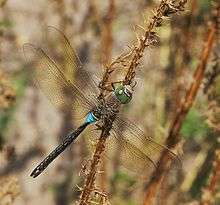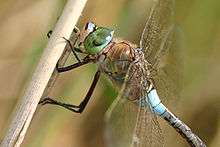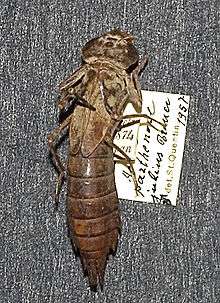Anax parthenope
| Lesser emperor | |
|---|---|
 | |
| Male | |
| | |
| Female | |
| Scientific classification | |
| Kingdom: | Animalia |
| Phylum: | Arthropoda |
| Class: | Insecta |
| Order: | Odonata |
| Family: | Aeshnidae |
| Genus: | Anax |
| Species: | A. parthenope |
| Binomial name | |
| Anax parthenope (Sélys, 1839[1]) Original genus: Aeshna | |
Anax parthenope, the lesser emperor, is a dragonfly of the family Aeshnidae. It is found in Southern Europe, north Africa, and Asia.
Identification
A. parthenope is smaller and less colourful than the Anax imperator. In general appearance, especially when seen on the wing, A. parthenope is similar to A. imperator but A. parthenope tends to hold its abdomen straighter than A. imperator. A large dragonfly seen in flight with a bent abdomen is most likely to be A. imperator rather than A. parthenope. A. parthenope has a blue saddle at S2 and S3 which can be seen in flight which is in contrast to the rest of the abdomen which is brown. There is a yellow rin at the base of S2. The eyes are green. It is similar to A. ephippiger although A. ephippiger is slightly smaller and slenderer and its blue saddle does not wrap around S2 but is mostly blue on top. A. ephippiger has brown eyes.

Distribution and habitat
Occurs in much of southern and central Europe including most Mediterranean islands, across Asia to Japan, Korean Peninsula and China, and north Africa. It has been found on the Canary islands and the Madeira archipelago. It is spreading north and was first seen in Great Britain in 1996 where it has since bred.[2]
Behaviour

In the south of its range A. parthenope can be on the wing in March. It is most commonly seen from June to September but can still be around in November. Often seen patrolling around ponds, lakes and other still water. Where it occurs with A. imperator it is usually less abundant. When A. parthenope and A. imperator occur at the same ponds A. imperator is dominant. Male and females mate in the normal dragonfly manner and after mating the pair stay in tandem and egg-laying usually occurs whilst still in tandem. This behaviour not seen in other European hawkers with the exception of Aeshna affinis, although two migrants to Europe, A. ephippiger and A. junius also oviposit in tandem. Eggs are inserted into plants or in mud and hatch out in two months. Larval development takes two years.
References
- Askew, R.R. (2004). The Dragonflies of Europe. (revised ed.) Harley Books. ISBN 0-946589-75-5
- d'Aguilar, J., Dommanget, JL., and Prechac, R. (1986). A field guide to the Dragonflies of Britain, Europe and North Africa. Collins. pp.336. ISBN 0-00-219436-8
- Boudot JP. et al. (2009). Atlas of the Odonata of the Mediterranean and North Africa. Libellula Supplement 9:1-256.
- Dijkstra, K-D.B & Lewington, R. (2006). Field Guide to the Dragonflies of Britain and Europe. British Wildlife Publishing. ISBN 0-9531399-4-8.
- ↑ Bulletins de l'Académie royale des sciences, des lettres et des beaux-arts de Belgique, 6 (1839), 389
- ↑ "Lesser Emperor". British Dragonfly Society. Retrieved 10 August 2011.
External links
| Wikimedia Commons has media related to Anax parthenope. |